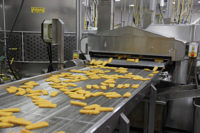
Though the Bryan Adams song referenced in the headline makes the task sound simplistic, to those of us in the meat industry, cutting like a knife isn’t always that easy (especially when the edge of the blade has been rolled).
Whether we are boning out a chuck, clipping tenders, or cutting hocks, sharpness of blades and the set on blades dramatically affect the cut and the operator. Try cutting through cardboard with dull scissors or with blunt-ended safety scissors—it’s not an easy task and adds stresses to the arm and hand. Now do this task 8 to 10 hours a day, and you will quickly cut through your workforce.
I believe our industry has reached a plateau in knife and edge technology. So what can be done to improve the physical cut of the meat, improve yields, reduce risk factors associated with cumulative trauma disorders and reduce operating costs? There are three basic issues being addressed by various groups:
1. improve the blades and tool/equipment design
2. maintain sharpness (operator training), and
3. provide mechanical assistance to the operators’ functions
Some equipment manufacturers have led the way in developing technology to improve the cutting ability of tools and equipment as well as the interaction between tool and operator. Different metals have been tested and are being used in knives and scissors as well as a variety of heat-treatment processes. Longer life of the tools has provided a cost benefit to the end user as well as reducing some risk factors to the operator. Improved handles on manual tools to accommodate various hand sizes has reduced the risks associated with cumulative trauma disorders. Yet there remains the interaction between an operator and the tool since the onerous task of maintaining the knives’ sharpness rests on the end user.
When I pick up my knives from the knife room before shift, I expect each one to be sharp. Improved sharpening equipment has lead to reduced knife usage as well as better knife sharpening for the personnel in the knife room. But, starting off with sharp knives doesn’t guarantee that I’ll keep that edge throughout the day. Once I hit a bone or the edge of the conveyor and roll the edge, I’ll be going back to the knife room at break.
And this is where the skill level of many knife handlers to steel their blades has been lost. You can go on any production floor and see workers struggling with their knives or scissors because the edge is gone. Bringing an edge back is a trained skill which is almost lost, but one piece of equipment has been a tremendous saver and that is the “mousetrap” steel. Of course it will not help with a rolled edge, but it will keep a sharp blade sharp and eliminates training time and skill.
No matter how blades are improved, what new metals introduced, what skills taught, or even in the future, what “never dull knife edge” is created, there is still an operator connected to that equipment. In order to get off our current plateau and advance cutting technology, mechanical assistance and robotics need to be applied to manual tasks and supplant operators. This concept is quickly gaining acceptance as washdown robotic cells are allowing applications to be realized in adverse environments.
Automatic split saws, robotic hock cutters, automatic loin pullers, rib pullers and a variety of vision systems are leading the way to the inevitable future of our industry.
Cutting technology is part of the automation future of the meat industry as force feedback will allow machines to interpret muscle density, firmness and fat/lean interface, and adjust the cutting pressures and paths accordingly.
The next several years will be exciting as technology applied to cutting equipment and tools will allow us to “sharpen” our focus on safety, efficiencies and sustainability.


Report Abusive Comment